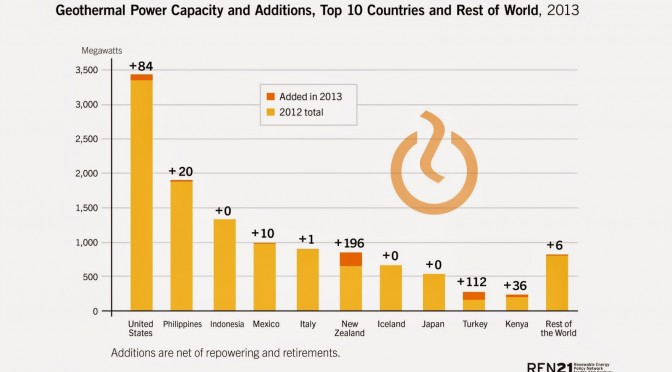Geothermal resources provide energy in the form of electricity and direct heating and cooling, totalling an estimated 600 PJ (167 TWh) in 2013.
Geothermal electricity generation is estimated to be a little less than half of the total final geothermal output, at 76 TWh, with the remaining 91 TWh (328 PJ) representing direct use.
Some geothermal plants produce both electricity and thermal output for various heat applications.
At least 530 MW of new geothermal power generating capacity came on line in 2013, bringing total global capacity to 12 GW, generating an estimated 76 TWh annually.
Countries that added capacity in 2013 were New Zealand, Turkey, the United States, Kenya, Mexico, the Philippines, Germany, Italy, and Australia.
Turkey added at least 112 MW of geothermal generating capacity in 2013, for a total of at least 275 MW. Most notable may be the installation of a 60 MW triple-flash turbine in the Denizli field. Other capacity to come on line in Turkey in 2013 was made up of smaller binary units. Turkey promises to be an important market in the region in the near future, with over 300 MW of additional capacity under licence or construction at year’s end.
The United States added 84 MW of geothermal generating capacity in 2013, for a total of 3.4 GW, representing nearly 29% of total world operating capacity. One of the larger U.S. plants to come on line in 2013 was Enel Green Power’s 25 MW binary plant in Fort Cove, Utah. Although relatively small in capacity, perhaps the most significant U.S. project completed in 2013 was the Desert Peak 2 (1.7 MW) in Nevada, the first commercial gridconnected EGS (enhanced or engineered geothermal system) installation in the United States.
Kenya is one of the fastest-growing geothermal power markets in the world. In 2013, the country added 36 MW of capacity at the Olkaria III complex. A further 16 MW was added to Olkaria III in early 2014, bringing the complex to a total of 110 MW. As of early 2014, Kenya had another 280 MW of geothermal power capacity under construction.
Mexico completed the second of two 25 MW units of the Los Humeros II project, replacing 15 MW of existing capacity. Ongoing reforms to Mexico’s energy laws are expected to spur growth and involvement of private parties in the country’s geothermal development.
Also in 2013, the Philippines began operations at the 20 MW Maibarara geothermal power plant.24 At year’s end, the country’s portfolio of geothermal power plants stood at 1.9 GW, second only to that of the United States, with another 40 MW expected to come on line in 2014.25
Several relatively small plants came on line in Europe during the year. Southern Germany has been active in development of binary plants with two 6 MW units completed near Munich in late 2012 and early 2013. In addition, Germany’s co-generating Sauerlach binary plant (5 MW / 4 MWth) was inaugurated in January 2014, delivering heat in addition to electricity.
Geothermal direct use refers to direct thermal extraction for heating and cooling, exclusive of heat pumps. The main applications for direct use of geothermal energy are space heating (including district heat networks), domestic hot water supply, direct and indirect heating of public baths and swimming pools, greenhouse heating, industrial process heat, aquaculture, and agricultural drying.
Geothermal direct use continued to grow during 2013, with capacity added in at least a number of European countries. It is estimated that global direct use was in the range of 280–375 PJ during 2013, with a mean of 328 PJ (91 TWh). This wide range reflects widely varying data for China, which is a significant user of geothermal for heat purposes. The collection of data on direct use of geothermal energy is lacking.
Direct use is concentrated among the few countries where good geothermal resources coincide with heat demand that can easily be served by the resource, such as Iceland, and where geothermal heat has served both industry and social traditions, such as thermal baths in Japan, Turkey, and Italy.
China remains the presumptive leader in direct geothermal energy use, but estimates range from 13 TWh in 2009 to 45 TWh in 2011, or about 20–50% of global output. Other top users
of direct geothermal heat are Turkey (estimated 16.4 TWh in 2012), Iceland (7.8 TWh in 2013), Japan (7.2 TWh in 2013), and Hungary (2.8 TWh in 2012).
Among notable new thermal plants that opened in 2013 is a district heating plant (60–70 MWth) in Miskolc, Hungary. The project exceeded initial expectations and is considered to be among the better low-temperature wells in mainland Europe, producing 70–90 litres per second at 100 °C.43 In Italy, a 6 MWth district heat system was inaugurated by Enel Green Power in April to serve municipalities in Tuscany. In early 2014, a cogeneration plant with thermal capacity of 4 MWth was inaugurated in Sauerlach, Germany.
In Europe, there have been recent efforts to improve accounting of direct use geothermal energy across all sectors, specifically balneology (e.g., spas, swimming pools), which may not have been fully reported before.
http://santamarta-florez.blogspot.com.es/2014/06/530-mw-of-new-geothermal-energy.html



